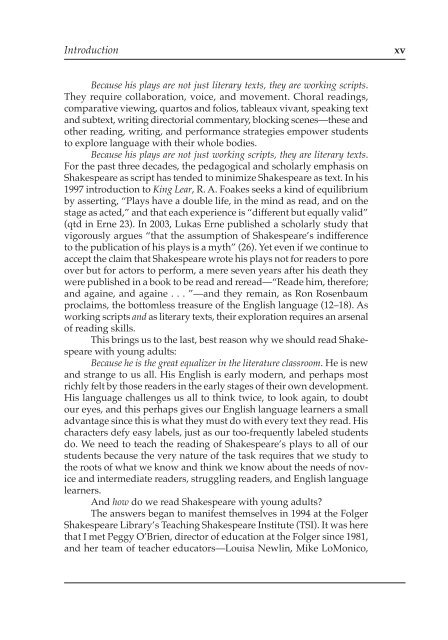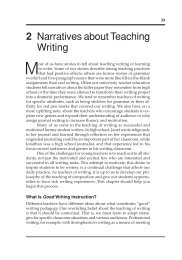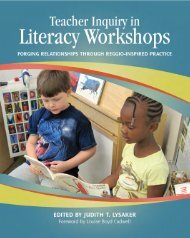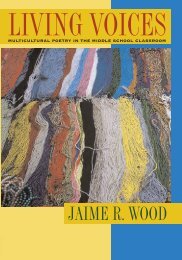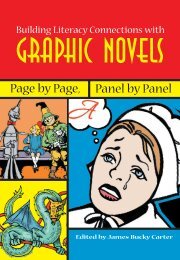reading Shakespeare
reading Shakespeare
reading Shakespeare
Create successful ePaper yourself
Turn your PDF publications into a flip-book with our unique Google optimized e-Paper software.
Introduction<br />
xv<br />
Because his plays are not just literary texts, they are working scripts.<br />
They require collaboration, voice, and movement. Choral <strong>reading</strong>s,<br />
comparative viewing, quartos and folios, tableaux vivant, speaking text<br />
and subtext, writing directorial commentary, blocking scenes—these and<br />
other <strong>reading</strong>, writing, and performance strategies empower students<br />
to explore language with their whole bodies.<br />
Because his plays are not just working scripts, they are literary texts.<br />
For the past three decades, the pedagogical and scholarly emphasis on<br />
<strong>Shakespeare</strong> as script has tended to minimize <strong>Shakespeare</strong> as text. In his<br />
1997 introduction to King Lear, R. A. Foakes seeks a kind of equilibrium<br />
by asserting, “Plays have a double life, in the mind as read, and on the<br />
stage as acted,” and that each experience is “different but equally valid”<br />
(qtd in Erne 23). In 2003, Lukas Erne published a scholarly study that<br />
vigorously argues “that the assumption of <strong>Shakespeare</strong>’s indifference<br />
to the publication of his plays is a myth” (26). Yet even if we continue to<br />
accept the claim that <strong>Shakespeare</strong> wrote his plays not for readers to pore<br />
over but for actors to perform, a mere seven years after his death they<br />
were published in a book to be read and reread—“Reade him, therefore;<br />
and againe, and againe . . . ”—and they remain, as Ron Rosenbaum<br />
proclaims, the bottomless treasure of the English language (12–18). As<br />
working scripts and as literary texts, their exploration requires an arsenal<br />
of <strong>reading</strong> skills.<br />
This brings us to the last, best reason why we should read <strong>Shakespeare</strong><br />
with young adults:<br />
Because he is the great equalizer in the literature classroom. He is new<br />
and strange to us all. His English is early modern, and perhaps most<br />
richly felt by those readers in the early stages of their own development.<br />
His language challenges us all to think twice, to look again, to doubt<br />
our eyes, and this perhaps gives our English language learners a small<br />
advantage since this is what they must do with every text they read. His<br />
characters defy easy labels, just as our too-frequently labeled students<br />
do. We need to teach the <strong>reading</strong> of <strong>Shakespeare</strong>’s plays to all of our<br />
students because the very nature of the task requires that we study to<br />
the roots of what we know and think we know about the needs of novice<br />
and intermediate readers, struggling readers, and English language<br />
learners.<br />
And how do we read <strong>Shakespeare</strong> with young adults<br />
The answers began to manifest themselves in 1994 at the Folger<br />
<strong>Shakespeare</strong> Library’s Teaching <strong>Shakespeare</strong> Institute (TSI). It was here<br />
that I met Peggy O’Brien, director of education at the Folger since 1981,<br />
and her team of teacher educators—Louisa Newlin, Mike LoMonico,


